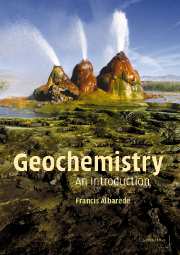Book contents
- Frontmatter
- Contents
- Foreword to the English edition
- Foreword to the French edition
- Acknowledgments
- Introduction
- 1 The properties of elements
- 2 Mass conservation – elemental and isotopic fractionation
- 3 Geochronology and radiogenic tracers
- 4 Element transport
- 5 Geochemical systems
- 6 Waters present and past
- 7 Mineral reactions
- 8 The solid Earth
- 9 The Earth in the Solar System
- 10 The geochemical behavior of selected elements
- Appendix A Composition of the major geological units
- Appendix B The mixing equation for ratios
- Appendix C A refresher on thermodynamics
- Appendix D The Rayleigh distillation equation
- Appendix E The geological time scale
- Appendix F An overview of analytical methods
- Appendix G Physical and geophysical constants
- Appendix H Some equations relative to residence time
- Further reading
- Index
Foreword to the English edition
- Frontmatter
- Contents
- Foreword to the English edition
- Foreword to the French edition
- Acknowledgments
- Introduction
- 1 The properties of elements
- 2 Mass conservation – elemental and isotopic fractionation
- 3 Geochronology and radiogenic tracers
- 4 Element transport
- 5 Geochemical systems
- 6 Waters present and past
- 7 Mineral reactions
- 8 The solid Earth
- 9 The Earth in the Solar System
- 10 The geochemical behavior of selected elements
- Appendix A Composition of the major geological units
- Appendix B The mixing equation for ratios
- Appendix C A refresher on thermodynamics
- Appendix D The Rayleigh distillation equation
- Appendix E The geological time scale
- Appendix F An overview of analytical methods
- Appendix G Physical and geophysical constants
- Appendix H Some equations relative to residence time
- Further reading
- Index
Summary
Modern geochemistry is a discipline that pervades nearly all of Earth science, from measuring geological time through tracing the origin of magmas to unravelling the composition and evolution of continents, oceans and the mantle, all the way to the understanding of environmental changes. It is a comparatively young discipline that was initiated largely by Goldschmidt in the 1930s, but its modern development and phenomenal growth started only in the 1950s. Although there are many journals dedicated to geochemical research, there have been remarkably few general geochemical textbooks that cover more than a limited segment of the full scope of modern geochemistry. This is one reason why Francis Albarède's new book is most welcome. It is written by the author of the authoritative and widely acclaimed Introduction to Geochemical Modeling (Cambridge University Press, 1995), and it is intended as an undergraduate introductory course in geochemistry. Its scope is large, though not all-inclusive, concentrating on the inorganic chemistry of the condensed part of our planet. Although it started out as a translation from the original French book, the new English-language edition is much more than just a translation. The entire text has been substantially revised and in some parts expanded, and it is really a new book. Yet it retains a distinctly French flavor, particularly in the way many subjects are addressed via mathematical description. This approach is entirely normal for a student of the French Ecole Normale or a French university, but it will surprise many American teachers and students of geology alike.
- Type
- Chapter
- Information
- GeochemistryAn Introduction, pp. ix - xPublisher: Cambridge University PressPrint publication year: 2003

